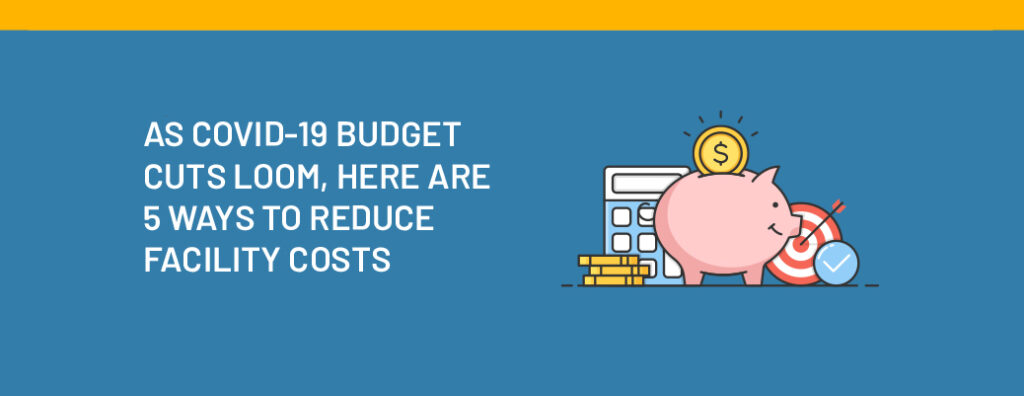
The last four to five months have been disruptive to almost every organization in one form or another. Some obstacles, like moving an operation from a traditional office setting to a virtual setting, have been overcome. Others, such as budget shortfalls, are still being felt and managed. These unplanned budget impacts have taken a negative toll on both capital projects and ongoing operations.
We wanted to share a few no cost/low cost ideas you can consider for your facilities to potentially save some needed operational dollars. Even if these options are not currently in place, it may be cost effective to implement them and add them to your standard operational work practices, knowing that any financial gains realized could be ongoing.
5 Ways to Reduce Facility Costs
1. Check the building occupancy schedules
Unless critical in nature, most buildings have an occupancy schedule programmed in the Building Management System (BMS) system. Make sure they are reasonable for your facility’s current operation, and most importantly, that they are implemented and not overridden.
2. Check the building’s outdoor air (OA) delivery
One of the recommendations from ASHRAE for COVID-19 mitigation is to increase outdoor air intake into a facility, which in turn displaces air already in the building. Reasonably increasing outdoor air is a good strategy for COVID-19 mitigation and an overall healthy building. The key word is “reasonably.” Remember that outdoor air is typically the most expensive to condition. And too much outdoor air can be detrimental if the mechanical system was not designed to condition the volume of outdoor air being introduced to the building. This could lead to potential indoor air quality issues like microbial growth. Minimum outdoor air design should always be met, and if done responsibly, potentially increased, but never to the point of overloading the ability of the air handling unit to properly condition the outdoor air being brought into the building.
3. Check your building management system
Make sure mechanical equipment designed to be controlled by the BMS system is configured to do so. Check starters and variable speed drives to make sure they are not in “hand” mode resulting in equipment operating continuously whether needed or not. Check key system sensors, like supply air or space temperature and humidity, are operational and calibrated. Check outdoor air flow stations, demand control ventilation routines, and CO2 sensors to make sure they are operational, and that outdoor air is being controlled to the correct setpoints. Check for overridden control outputs in the system, such as dampers and valves. Determine why the override is in place. Perhaps it was initiated during a component failure, which has since been corrected, but the override never released.
4. Improve facility water efficiency
Buildings built in the last several years already have high efficiency plumbing fixtures. If dealing with a lot of older buildings, perhaps there is an opportunity to save water, and in turn, sewage costs. Most lavatories can accept a low flow aerator. They are inexpensive and easily installed. Low flow shower heads are also a great idea if you have changing rooms or shower facilities that have not been updated recently. If the facility has a cooling tower, considering adding an inexpensive submeter on the makeup water line to measure tower water and potentially avoid the associated sewage costs. Most municipalities recognize that cooling tower makeup water is not sent to the sewer, it is evaporated. By measuring the water being consumed by the cooling tower, and subtracting that from the overall building water meter, you determine the amount of water actually sent to the sewer system, resulting in only paying sewer fees for that portion of water disposed.
5. Make sure the building lighting investment is paying off
Lighting costs have improved a great deal in the last several years and building owners have undertaken comprehensive lighting retrofits to improve building lighting quality while decreasing energy use. While LED fixtures are cost competitive, produce great light levels, and use much less energy, lighting is still a key energy component in a large commercial building. If the facility has room occupancy sensors, make sure they work. Almost all wall mounted occupancy sensors have a manual override switch. Make sure it is in the occupancy mode and not overridden to be on continuously. If lighting contactors are used in the facility, make sure they use the correct occupancy schedule and de-energize the lights when not needed. It is not uncommon for a 24/7 schedule to be implemented or a contactor to be put in “Hand” if equipped with a Hand-Off-Auto switch. Check that photocells used for exterior lights are operational. If exterior lighting is energized in the middle of the day, it is a giveaway that something is amiss and should be corrected.
In addition to these tips, consider augmenting your BMS system with a monitoring-based commissioning (MBCx) solution. Simply having access to BMS data does not directly translate to reduced energy consumption, energy savings, or extended equipment lifespans. BMS systems are great for centralized control and they may be programmed with some key alarms which can notify the O&M team when a critical failure occurs, but they are typically not configured to identify and prioritize equipment performance.
An MBCx solution does just that. It utilizes the data already generated by the BMS and then actually system performance using an analytics engine. Areas of concern are prioritized. From there, an action plan can easily be developed to address those concerns and easily communicated to O&M personnel, saving time. Equipment can be serviced quickly, saving energy, and decreasing occupant complaints. With a robust MBCx solution, it is not uncommon for an issue to be resolved before the occupants know one exists. It also makes sense economically. For example, a recent application of MBCx at a public school district in Maryland identified improper sequencing of the chiller plant’s lead/lag sequence of operation causing both chillers to operate under part load. Correcting the sequencing resulted in an estimated $100,000 in energy cost avoidance. Knowing that your building is operating as efficiently as possible while simultaneously being able to focus O&M efforts and improve occupant comfort is a win-win-win. Feel free to reach out to us to learn more about Monitoring Based Commissioning.
Stay healthy, safe, and comfortable.




